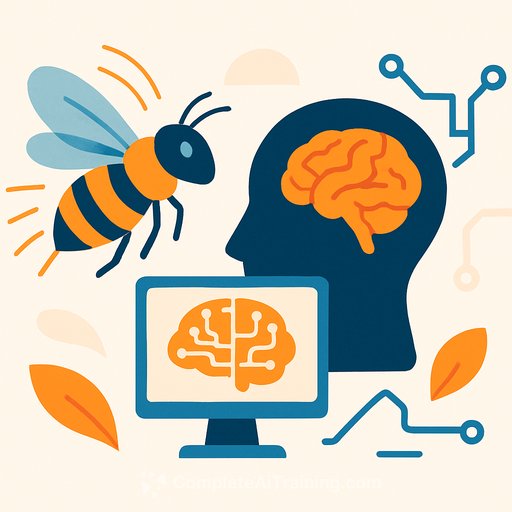Why tiny bee brains could hold the key to smarter AI
Summary
Researchers have found that bees use their flight movements to sharpen brain signals, allowing them to recognize patterns with surprising accuracy. A digital model of the bee brain reveals that this movement-based perception may lead to smarter, more efficient AI and robotics by focusing on efficiency instead of massive computing power.
How bees combine brain and body for efficient perception
Bees integrate their brain and body in unexpected ways, using flight movements to simplify complex visual tasks. A recent study from the University of Sheffield developed a digital model of a bee’s brain, showing how these movements generate clear and efficient neural signals. This enables bees to decode visual information effectively during flight.
Instead of relying on large networks or heavy computation, bees leverage their motion to actively shape what they see. This approach allows them to recognize intricate patterns—like those on flowers—with remarkable precision and minimal neural resources.
Intelligence from interaction: brain, body, and environment
The study emphasizes that intelligence arises from the interaction between brain, body, and environment. Tiny insect brains, despite having very few neurons, solve complex visual tasks efficiently. This finding challenges assumptions about brain size and intelligence and offers new directions for AI development.
By building a computational model of a bee’s neural circuits, researchers showed that flight movements help shape visual input, producing unique electrical signals in the brain. These signals enable bees to identify consistent features in their surroundings while conserving energy and processing power.
Implications for AI and robotics
This digital model not only improves understanding of bee cognition but also points toward designing AI and robots that use movement to collect relevant information. Instead of scaling up hardware, future systems could achieve smarter perception through active sensing strategies inspired by bees.
Professor James Marshall, Director of the Centre of Machine Intelligence at the University of Sheffield, highlighted that small, efficient systems—refined by evolution—can perform complex computations. This insight paves the way for advancements in robotics, autonomous vehicles, and real-world learning.
From scanning shortcuts to neural efficiency
The research builds on previous findings about how bees use active vision—movement-driven visual processing—to solve puzzles. The new study uncovers the brain mechanisms behind this behavior. It shows that bees’ neurons adapt to specific directions and movements through repeated exposure, forming reliable patterns without needing reinforcement or rewards.
This means bees learn by observing during flight, using only a small number of active neurons. This efficiency conserves energy and avoids the need for large-scale computation.
Testing the model: visual pattern discrimination
To validate the model, researchers tested it on tasks real bees face, such as distinguishing a 'plus' sign from a 'multiplication' sign. The model’s performance improved significantly when mimicking bees’ strategy of scanning only the lower half of patterns—a behavior observed in earlier studies.
Even with a small network of artificial neurons, the model successfully recognized human faces, demonstrating the power and flexibility of bee-inspired visual processing.
Expert insights on insect microbrains and intelligence
Professor Lars Chittka from Queen Mary University of London noted that brain size alone is a poor predictor of intelligence. The study identifies the minimal neuron count needed for complex visual tasks, showing that insect microbrains can perform advanced computations despite their size.
Professor Mikko Juusola of the University of Sheffield explained that animals actively shape the information they receive. The new model extends this principle to complex visual processing in bees, illustrating how behavior-driven scanning creates compressed, learnable neural codes. This supports a unified view where perception, action, and brain dynamics co-adapt to solve tasks efficiently.
Conclusion: Lessons from tiny brains for AI
This study connects insect behavior, neurobiology, and computational modeling to reveal essential principles of intelligence. It highlights how small brains achieve efficient cognition through active sensing and neural adaptation, offering valuable insights for both biology and AI development.
For researchers and professionals interested in AI that emphasizes efficiency and real-world learning, exploring biologically inspired designs like this can open new pathways. More on AI strategies and training can be found at Complete AI Training.
Your membership also unlocks:






